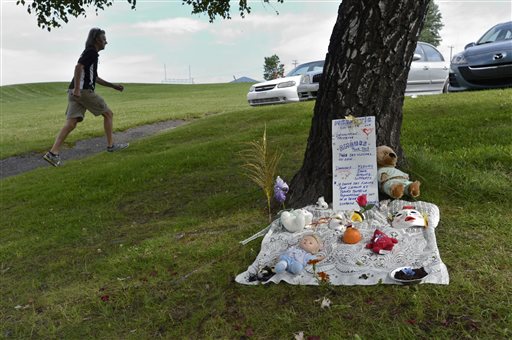Families of people who were killed in a fiery train derailment in Lac-Megantic, Quebec, last month likely are entitled to hundreds of millions of dollars in damages, according to a motion filed in U.S. Bankruptcy Court.
The motion argues that plaintiffs in a wrongful-death lawsuit against the Montreal, Maine & Atlantic Railway have a right to participate in the Maine-based company’s bankruptcy case, since they are expected to receive most of its remaining assets.
According to the railroad’s bankruptcy petition, its total net worth is $50 million to $100 million.
The motion, filed Aug. 22, requests the formation of a committee to represent wrongful-death and accident-injury claimants in the railroad’s ongoing Chapter 11 bankruptcy proceedings.
Federal law gives claimants in any wrongful-death and personal-injury lawsuits against a railroad priority over other creditors in that railroad’s bankruptcy reorganization. That does not include creditors on loans backed by specific collateral such as property or equipment.
According to the motion, filed on behalf of 33 of the 47 people who died in the derailment, explosion and fire on July 6, victims’ claims likely will far exceed the railroad company’s net worth.
“Given the horrific circumstances of the disaster and the debtor’s role in it, wrongful death verdicts in the hundreds of millions of dollars can be expected,” says the motion, filed by a Bangor attorney, George Kurr Jr.
Operation of the railway, which runs from Quebec toward New Brunswick through central Maine, has been in jeopardy since an unattended train hauling 72 cars of crude oil rolled into the small town in Quebec, derailed and exploded.
The Montreal, Maine & Atlantic filed for bankruptcy protection about a month after the derailment.
The motion offers several arguments why the court should allow the formation of a committee to represent the interests of victims and their families.
One argument is that the claimants, many of whom do not speak English, deserve qualified representatives who understand U.S. bankruptcy cases and can stick up for their rights.
“The decedents were unsophisticated individuals who happened to be in a small-town cafe when it, and they, were incinerated by the debtor’s runaway train,” the motion says.
Forming a creditors’ committee made up entirely of victims’ representatives also would help move the bankruptcy case forward, it says, because no reorganization plan could be approved without buy-in from the victims and their families.
“If, as seems inevitable because of the amount they are owed, bodily injury claimants remain unpaid at the time a plan is considered for confirmation, the plan may not be confirmed without paying them the full amount they are owed, in cash,” the motion says.
The only exception would be if the victims and their representatives agreed to accept less than they are owed, it says, which could be accomplished only through negotiation.
“Agreements require negotiations, and negotiations require adequate representation of the parties, which, in the case of wrongful death and personal injury claimants, only an official committee can assure,” the motion says.
According to Section 1171(a) of the U.S. Bankruptcy Code, victims of a train crash and their families are treated as administrative creditors in that train operator’s bankruptcy case.
Administrative creditors, which also include the lawyers and bankruptcy experts who represent the debtor, generally receive compensation even before the bankruptcy case is resolved.
The Montreal, Maine & Atlantic bankruptcy case is complex and likely will take years to resolve, legal experts have said.
During a bankruptcy hearing this month, Judge Louis Kornreich expressed concern that litigation costs would drain the railroad of all of its remaining funds.
In response, an attorney representing the railroad said he had approached the company’s creditors about letting the company borrow money to pay for its bankruptcy case.
According to documents filed in bankruptcy court, the railway company is worth $50 million to $100 million and owes at least $37 million to its largest creditors. In all, the company estimates that it has more than 200 unsecured creditors, which are businesses or individuals who are owed money but do not have collateral or legal means to force repayment.
Several lawsuits have been filed since the accident, including a potential class action by victims and by family members of victims.
The railroad’s chairman, Ed Burkhardt, has said that the company’s obligations exceed the value of its assets, including its expected insurance payouts from the accident. The company did not respond to a request for comment on this story.
The Montreal, Maine & Atlantic owns 512 miles of line in Maine and Canada. Most of its workers have been laid off since the accident disrupted operations.
Because it operates in two countries, the railroad consists of two companies, the Montreal, Maine & Atlantic Canada Co. in Canada and the Montreal, Maine & Atlantic Railway Ltd. in the United States. Each company has its own board of directors.
The Canadian company filed for bankruptcy under Canadian law in Superior Court of Quebec in Montreal, while its sister company in Maine filed for protection from creditors under Chapter 11 of the U.S. Bankruptcy Code.
Because railroads are critical for commerce and have monopoly status, U.S. bankruptcy law has special rules to ensure that they continue to operate and are not liquidated. In fact, railroads are not allowed to file for Chapter 7 bankruptcy, which is used when a company closes its business and sells off its assets.
A hearing on the motion to form a committee to represent wrongful-death and personal-injury claimants is scheduled for 10 a.m. Oct. 3 in U.S. Bankruptcy Court in Bangor.
J. Craig Anderson can be contacted at 791-6390 or at:
canderson@pressherald.com
Twitter: @jcraiganderson
Send questions/comments to the editors.




Comments are no longer available on this story